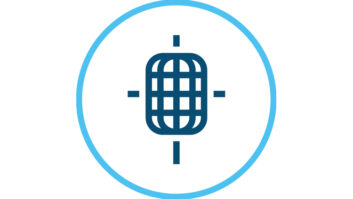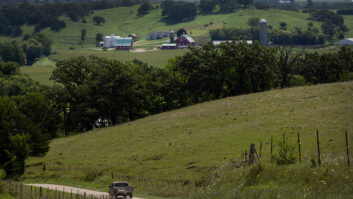
If you want to buy a longwave radio today, you will
likely have to find a used receiver such as this radio
in Lisburn, Ireland. Credit: Notafly/Wiki Commons
Readers have posted several comments and clarifications regarding information in this article; read them at bottom. RW welcomes your comments as well.
LONDON — When Irish state broadcaster Raidió Teilifís Éireann announced the closure of its longwave Radio 1 service to Britain — longwave being an analog, interference-plagued broadcast band in the 148.5–253 kHz range, below AM/medium wave — the last thing RTÉ expected was a firestorm of protest. After all, Radio 1 would still be available to British listeners on the Web and via the Freesat satellite TV service; even after RTÉ turned off its longwave transmitter on Jan. 1.
This proved to be no consolation to RTÉ’s longwave listeners. Led by the United Kingdom’s “Irish in Britain” Irish expatriate group — the U.K. is home to half a million Irish-born residents — and bolstered by the Irish Post newspaper and other media outlets, RTÉ’s longwave loyalists made their displeasure very, very clear to the Irish republic’s government, RTÉ, and anyone who would listen. The protest, which included public opinion polls supportive of RTÉ remaining on longwave plus petitions signed by 5,000-plus of RTÉ longwave fans, successfully persuaded the government to postpone RTÉ’s longwave closure until Jan. 1, 2017.
This retreat marks the third time that RTÉ has tried to shut down its “Longwave 252” service to Britain; each time backing down in the face of listener resistance. The January 2017 deadline may prove to be the fourth such defeat for RTÉ: In the wake of the latest extension, the Irish government has asked Irish in Britain to research the impact of a longwave shutdown in the future. To say the least, Irish in Britain remains unsympathetic to such a shutdown.
“There are many older Irish listeners in Britain who rely on Longwave 252 to listen to Irish football matches, and to stay in touch with home,” said Jennie McShannon, Irish in Britain’s chief executive. “These are people who don’t have the motivation or the money to tune in via satellite TV or the Internet — and who have perfectly good longwave radios in their homes already. They are happy with what they receive on longwave, and see no reason to change.”

The Antenna Farm at BBC Droitwich Credit: Bob Nienhuis
RETAINING USEFULNESS
The persistence of LW in ITU Zone 1 (Europe, Africa and Russia), the only part of the world for which longwave remains licensed for broadcasting, makes little obvious sense from a modern engineering perspective. After all, longwave hearkens back to the very earliest days of 20th century radio transmission; as does its higher frequency analog cousin AM/MW.
“The downside of LW is that it is only useful for spoken word broadcasts due to LW’s limited fidelity and vulnerability to interference,” said Denis Nowlan. He is network manager for BBC Radio 4, which offers a longwave service in addition to its FM, DAB and Web broadcasts.
“The upside is that thanks to its very long radio waves, long-wave can carry successfully over very long distances,” Nowlan said. “In fact, the BBC only needs three long-wave transmitters to cover all of the British Isles, plus up to 1,000 miles out to sea.” Long-wave’s “long reach” explains why it was adopted by European broadcasters decades ago, and why many still continue to run LW stations today.
“Longwave works just about anywhere, especially if you are mobile, whereas DAB drops out,” explained Alan Gale, U.K.-based longwave enthusiast and writer for the Longwave Club of America website. “DAB is for city dwellers. Longwave and medium wave are for the rest of us.”
In the same vein, long-wave’s ability to reach ships equipped with analog longwave receivers explains why Radio 4’s daily “Shipping Forecast” long-wave weather/tides broadcast remains “hugely popular among maritime listeners,” Nowlan said.

BBC Droitwich’s Longwave Antenna Towers
Overhead Credit: Arqiva
“In contrast, satellite-delivered weather data requires more expensive receiving equipment; something that older/smaller ship operators see no reason to install when long-wave works well enough.” (BBC Radio 4’s long-wave service also provides cricket test match coverage and summaries of yesterday’s parliamentary debates to its long-wave listeners.)
Britain isn’t the only maritime nation to rely on longwave to serve ships at sea, so does Norway. “We are airing on long-wave from Ingøy (Finnmark County) on 153 kHz, and for the time being there are no changes planned,” said Gjermund Svartvatn; a spokesperson with Norway’s public broadcaster NRK. “It’s a service mainly for boats in the Barents Sea, northern parts of Norwegian Sea and waters around Svalbard.”
TIME IS RUNNING OUT
Despite the continued usefulness of longwave, the medium is slowly losing radio stations as European and African broadcasters move to higher-fidelity, less expensive to operate FM and DAB platforms. “When you are broadcasting in longwave, you require antennas that are hundreds of meters long, and extraneously powerful transmitters to push that signal out,” said Nowlan. “Even with the extra range longwave offers, it is an expensive broadcast proposition; especially when FM, DAB, and the Web sound so much better. And no, there are no plans to bring digital radio to long-wave, as there are for AM/medium wave. It’s just not cost-effective.”
A case in point: The BBC’s main longwave transmitter station at Droitwich — which covers most of England and Wales — requires a massive 179-meter-long T-shaped wire antenna that is suspended between two 210-meter towers. This longwave antenna is powered using a 500 kW transmitter operating on 198 kHz. In contrast, the most powerful medium wave and shortwave transmitters are usually no bigger than 50 kW; while FM and DAB transmitters use far less power (but have much less geographic coverage). Their antennas are also much smaller.
Moreover, the parts needed to run the BBC’s long-wave transmitters are no longer being built, and the spares that remain are becoming few and farther between. The implications of this shortfall was grasped by the U.K.’s Guardian newspaper back in 2011.
“A handful of specially-crafted glass valves each measuring one-meter high are all that is stopping the historic home of ‘Test Match Special,’ ‘Yesterday in Parliament’ and the ‘Daily Service’ from going suddenly and permanently off air,” the Guardian stated in an article.

BBC Droitwich’s upper transmitter hall as it appeared in 1937,
with the longwave transmitter in the background and the control desk in the foreground. Credit: John Phillips archival collection.

In 1962, the BBC replaced its longwave transmitter and
control desk at BBC Droitwich’s upper transmitter hall.
Credit: John Phillips archival collection.
“BBC Radio 4 longwave, which transmits on the 198 kHz frequency, relies on aging transmitter equipment that uses a pair of valves [vacuum tubes] — no longer manufactured — to function,” said the Guardian “The valves, at Droitwich in Worcestershire, are so rare that engineers say there are fewer than 10 in the world, and the BBC has been forced to buy up the entire global supply. Each lasts anywhere between one and 10 years, and when one of the last two blows the service will go quiet.”
According to Nowlan, the Guardian report is accurate. “We have purchased whatever parts we can find, but the truth is that when our current longwave transmission equipment becomes irreparable, our long-wave service will be off-air for good,” he said. “The BBC has committed to continue to sustain the medium for as long as the current infrastructure is viable, but that’s it.”
At the same time, Nowlan cautions against writing Radio 4 longwave’s obituary — and that of longwave broadcasting in general — quite yet. “The BBC’s new charter will take effect in January 2017, and I am sure that longwave will be included in the charter,” he said. “Our longwave transmitters still have life in them, and so does our audience’s demand for longwave.”
James Careless reports on the industry for Radio World from Ottawa, Ontario.







